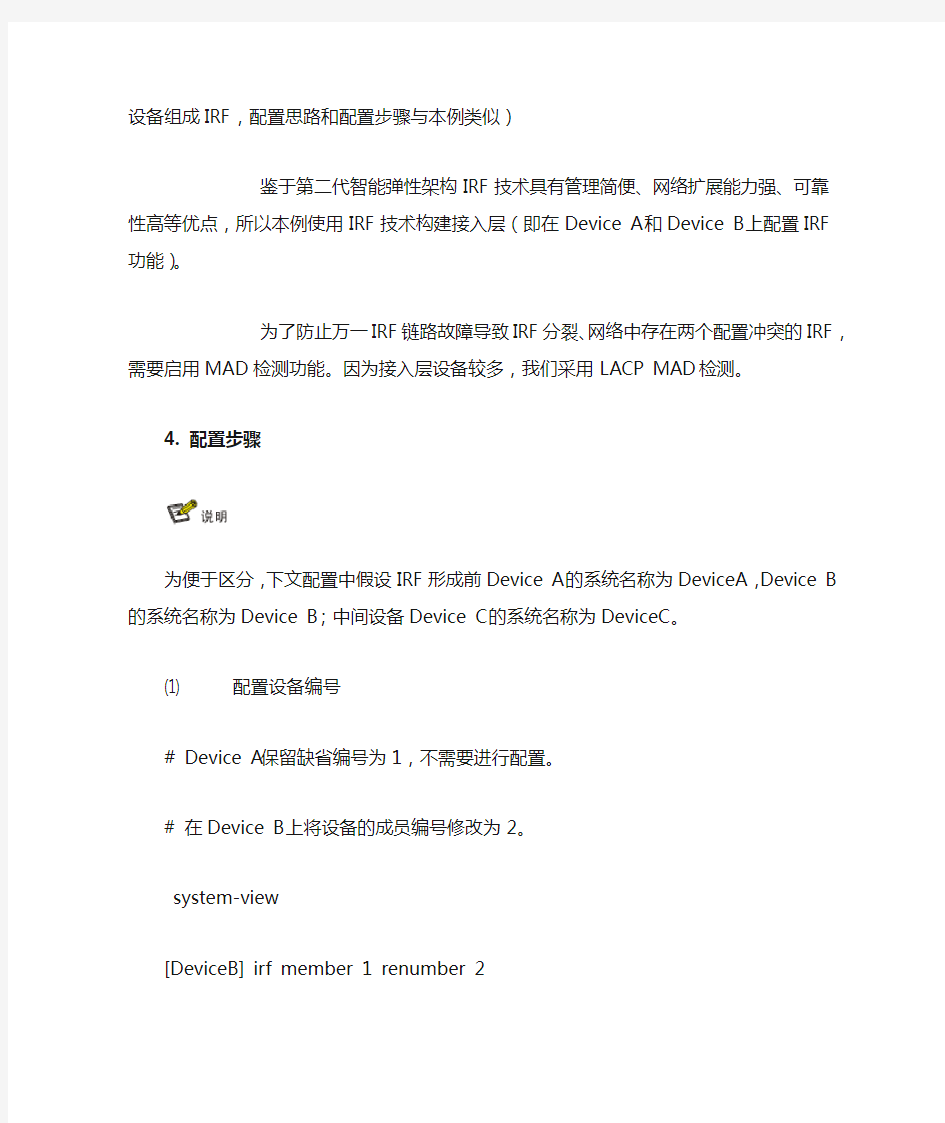IRF2-MAD


1.9 IRF典型配置举例
1.9.1 IRF典型配置举例(LACP MAD检测方式)
1. 组网需求
由于公司人员激增,接入层交换机提供的端口数目已经不能满足PC的接入需求。现需要在保护现有投资的基础上扩展端口接入数量,并要求网络易管理、易维护。
2. 组网图
图1-13 IRF典型配置组网图(LACP MAD检测方式)
3. 配置思路
●Device A提供的接入端口数目已经不能满足网络需求,需要另外增加一台设备Device B。(本文以两台设备组成IRF为例,在实际组网中可以根据需要,将多台设备组成IRF,配置思
路和配置步骤与本例类似)
●鉴于第二代智能弹性架构IRF技术具有管理简便、网络扩展能力强、可靠性高等优点,
所以本例使用IRF技术构建接入层(即在Device A和Device B上配置IRF功能)。
●为了防止万一IRF链路故障导致IRF分裂、网络中存在两个配置冲突的IRF,需要启用MAD检测功能。因为接入层设备较多,我们采用LACP MAD检测。
4. 配置步骤
为便于区分,下文配置中假设IRF形成前Device A的系统名称为DeviceA,Device B的系统名称为Device B;中间设备Device C的系统名称为DeviceC。
(1)配置设备编号
# Device A保留缺省编号为1,不需要进行配置。
# 在Device B上将设备的成员编号修改为2。
[DeviceB] irf member 1 renumber 2
Warning: Renumbering the switch number may result in configuration change or loss. Continue? [Y/N]:y
[DeviceB]
(2)将两台设备断电后,按图1-13所示连接IRF链路,然后将两台设备上电。
# 在Device A上创建设备的IRF端口2,与物理端口Ten-GigabitEthernet1/0/25绑定,并保存配置。
[DeviceA] interface ten-gigabitethernet 1/0/25
[DeviceA-Ten-GigabitEthernet1/0/25] shutdown
[DeviceA] irf-port 1/2
[DeviceA-irf-port 1/2] port group interface ten-gigabitethernet 1/0/25 [DeviceA-irf-port 1/2] quit
[DeviceA] interface ten-gigabitethernet 1/0/25
[DeviceA-Ten-GigabitEthernet1/0/25] undo shutdown
[DeviceA-Ten-GigabitEthernet1/0/25] save
# 在Device B上创建设备的IRF端口1,与物理端口Ten-GigabitEthernet2/0/26绑定,并保存配置。
[DeviceB] interface ten-gigabitethernet 2/0/26
[DeviceB-Ten-GigabitEthernet2/0/26] shutdown
[DeviceB] irf-port 2/1
[DeviceB-irf-port 2/1] port group interface ten-gigabitethernet 2/0/26 [DeviceB-irf-port 2/1] quit
[DeviceB] interface ten-gigabitethernet 2/0/26
[DeviceB-Ten-GigabitEthernet2/0/26] undo shutdown
[DeviceB-Ten-GigabitEthernet2/0/26] save
# 激活DeviceA的IRF端口配置。
[DeviceA-Ten-GigabitEthernet1/0/25] quit
[DeviceA] irf-port-configuration active
# 激活DeviceB的IRF端口配置。
[DeviceB-Ten-GigabitEthernet2/0/26] quit
[DeviceB] irf-port-configuration active
(3)两台设备间会进行Master竞选,竞选失败的一方将自动重启,重启完成后,IRF形成,系统名称统一为DeviceA。
(4)配置LACP MAD检测
# 创建一个动态聚合端口,并使能LACP MAD检测功能。
[DeviceA] interface bridge-aggregation 2
[DeviceA-Bridge-Aggregation2] link-aggregation mode dynamic
[DeviceA-Bridge-Aggregation2] mad enable
[DeviceA-Bridge-Aggregation2] quit
# 在聚合接口中添加成员端口GigabitEthernet1/0/1和GigabitEthernet2/0/1,专用于两台IRF成员设备与中间设备进行LACP MAD检测。
[DeviceA] interface gigabitethernet 1/0/1
[DeviceA-GigabitEthernet1/0/1] port link-aggregation group 2
[DeviceA-GigabitEthernet1/0/1] quit
[DeviceA] interface gigabitethernet 2/0/1
[DeviceA-GigabitEthernet2/0/1] port link-aggregation group 2
(5)中间设备Device C的配置
Device C作为一台中间设备需要支持LACP功能,用来转发、处理LACP协议报文,协助Device A和Device B进行多Active检测。从节约成本的角度考虑,使用一台支持LACP功能的交换机即可。
# 创建一个动态聚合端口。
[DeviceC] interface bridge-aggregation 2
[DeviceC-Bridge-Aggregation2] link-aggregation mode dynamic
[DeviceC-Bridge-Aggregation2] quit
# 在聚合端口中添加成员端口GigabitEthernet1/0/1和GigabitEthernet1/0/2,用于进行LACP MAD检测。
[DeviceC] interface gigabitethernet 1/0/1
[DeviceC-GigabitEthernet1/0/1] port link-aggregation group 2
[DeviceC-GigabitEthernet1/0/1] quit
[DeviceC] interface gigabitethernet 1/0/2
[DeviceC-GigabitEthernet1/0/2] port link-aggregation group 2
# 按图1-13所示连接LACP MAD链路。
1.9.2 IRF典型配置举例(BFD MAD检测方式)
1. 组网需求
由于网络规模迅速扩大,当前中心交换机(Device A)转发能力已经不能满足需求,现需要在保护现有投资的基础上将网络转发能力提高一倍,并要求网络易管理、易维护。
2. 组网图
图1-14 IRF典型配置组网图(BFD MAD检测方式)
3. 配置思路
●Device A处于局域网的汇聚层,为了将汇聚层的转发能力提高一倍,需要另外增加一台设备Device B。
●鉴于第二代智能弹性架构IRF技术具有管理简便、网络扩展能力强、可靠性高等优点,所以本例使用IRF技术构建网络汇聚层(即在Device A和Device B上配置IRF功能),接入层设备通过聚合双链路上行。
●为了防止万一IRF链路故障导致IRF分裂、网络中存在两个配置冲突的IRF,需要启用MAD检测功能。因为成员设备比较少,我们采用BFD MAD检测方式来监测IRF的状态。
4. 配置步骤
为便于区分,下文配置中假设IRF形成前Device A的系统名称为DeviceA,Device B的系统名称为Device B。
(1)配置设备编号
# Device A保留缺省编号为1,不需要进行配置。
# 在Device B上将设备的成员编号修改为2。
[DeviceB] irf member 1 renumber 2
Warning: Renumbering the switch number may result in configuration change or loss. Continue? [Y/N]:y
[DeviceB]
(2)将两台设备断电后,按图1-14所示连接IRF链路,然后将两台设备上电。
# 在Device A上创建设备的IRF端口2,与物理端口Ten-GigabitEthernet1/0/25绑定,并保存配置。
[DeviceA] interface ten-gigabitethernet 1/0/25
[DeviceA-Ten-GigabitEthernet1/0/25] shutdown
[DeviceA] irf-port 1/2
[DeviceA-irf-port 1/2] port group interface ten-gigabitethernet 1/0/25
[DeviceA-irf-port 1/2] quit
[DeviceA] interface ten-gigabitethernet 1/0/25
[DeviceA-Ten-GigabitEthernet1/0/25] undo shutdown
[DeviceA-Ten-GigabitEthernet1/0/25] save
# 在Device B上创建设备的IRF端口1,与物理端口Ten-GigabitEthernet2/0/26绑定,并保存配置。
[DeviceB] interface ten-gigabitethernet 2/0/26
[DeviceB-Ten-GigabitEthernet2/0/26] shutdown
[DeviceB] irf-port 2/1
[DeviceB-irf-port 2/1] port group interface ten-gigabitethernet 2/0/26
[DeviceB-irf-port 2/1] quit
[DeviceB] interface ten-gigabitethernet 2/0/26
[DeviceB-Ten-GigabitEthernet2/0/26] undo shutdown
[DeviceB-Ten-GigabitEthernet2/0/26] save
# 激活DeviceA的IRF端口配置。
[DeviceA-Ten-GigabitEthernet1/0/25] quit
[DeviceA] irf-port-configuration active
# 激活DeviceB的IRF端口配置。
[DeviceB-Ten-GigabitEthernet2/0/26] quit
[DeviceB] irf-port-configuration active
(3)两台设备间将会进行Master竞选,竞选失败的一方将自动重启,重启完成后,IRF形成,系统名称统一为DeviceA。
(4)配置BFD MAD检测
# 创建VLAN 3,并将Device A上的端口GigabitEthernet1/0/1和Device B上的端口GigabitEthernet2/0/1加入VLAN中。
[DeviceA] vlan 3
[DeviceA-vlan3] port gigabitethernet 1/0/1 gigabitethernet 2/0/1
[DeviceA-vlan3] quit
# 创建VLAN接口3,并配置MAD IP地址。
[DeviceA] interface vlan-interface 3
[DeviceA-Vlan-interface3] mad bfd enable
[DeviceA-Vlan-interface3] mad ip address 192.168.2.1 24 member 1
[DeviceA-Vlan-interface3] mad ip address 192.168.2.2 24 member 2
[DeviceA-Vlan-interface3] quit
# 按图1-14所示连接BFD MAD链路。
# 因为BFD MAD和生成树功能互斥,所以在GigabitEthernet1/0/1和GigabitEthernet2/0/1上关闭生成树协议。
[Sysname] interface gigabitethernet 1/0/1
[Sysname-gigabitethernet-1/0/1] undo stp enable
[Sysname-gigabitethernet-1/0/1] quit
[Sysname] interface gigabitethernet 2/0/1
[Sysname-gigabitethernet-2/0/1] undo stp enable
1.9.3 IRF典型配置举例(ARP MAD检测方式)
1. 组网需求
由于网络规模迅速扩大,当前中心交换机(Device A)转发能力已经不能满足需求,现需要在保护现有投资的基础上将网络转发能力提高一倍,并要求网络易管理、易维护。
2. 组网图
图1-15 IRF典型配置组网图(ARP MAD检测方式)
3. 配置思路
●Device A处于局域网的汇聚层,为了将汇聚层的转发能力提高一倍,需要另外增加一台设备Device B。
●鉴于第二代智能弹性架构IRF技术具有管理简便、网络扩展能力强、可靠性高等优点,所以本例使用IRF技术构建网络接入层(即在Device A和Device B上配置IRF功能),IRF 通过双链路上行。
●为了防止万一IRF链路故障导致IRF分裂、网络中存在两个配置冲突的IRF,需要启用MAD检测功能。因为成员设备比较少,我们采用ARP MAD检测方式来监测IRF的状态,复用
链路上行传递ARP MAD报文。为防止环路发生,在IRF和Device C上启用MSTP功能。4. 配置步骤
为便于区分,下文配置中假设IRF形成前Device A的系统名称为DeviceA,Device B的系统名称为Device B;中间设备Device C的系统名称为DeviceC。
(1)配置设备编号
# Device A保留缺省编号为1,不需要进行配置。
# 在Device B上将设备的成员编号修改为2。
[DeviceB] irf member 1 renumber 2
Warning: Renumbering the switch number may result in configuration change or loss. Continue? [Y/N]:y
[DeviceB]
(2)将两台设备断电后,按图1-14所示连接IRF链路和ARP MAD检测链路,然后将两台设备上电。
# 在Device A上创建设备的IRF端口2,与物理端口Ten-GigabitEthernet1/0/25绑定,并保存配置。
[DeviceA] interface ten-gigabitethernet 1/0/25
[DeviceA-Ten-GigabitEthernet1/0/25] shutdown
[DeviceA] irf-port 1/2
[DeviceA-irf-port 1/2] port group interface ten-gigabitethernet 1/0/25
[DeviceA-irf-port 1/2] quit
[DeviceA] interface ten-gigabitethernet 1/0/25
[DeviceA-Ten-GigabitEthernet1/0/25] undo shutdown
[DeviceA-Ten-GigabitEthernet1/0/25] save
# 在Device B上创建设备的IRF端口1,与物理端口Ten-GigabitEthernet2/0/26绑定,并保存配置。
[DeviceB] interface ten-gigabitethernet 2/0/26
[DeviceB-Ten-GigabitEthernet2/0/26] shutdown
[DeviceB] irf-port 2/1
[DeviceB-irf-port 2/1] port group interface ten-gigabitethernet 2/0/26
[DeviceB-irf-port 2/1] quit
[DeviceB] interface ten-gigabitethernet 2/0/26
[DeviceB-Ten-GigabitEthernet2/0/26] undo shutdown
[DeviceB-Ten-GigabitEthernet2/0/26] save
# 激活DeviceA的IRF端口配置。
[DeviceA-Ten-GigabitEthernet1/0/25] quit
[DeviceA] irf-port-configuration active
# 激活DeviceB的IRF端口配置。
[DeviceB-Ten-GigabitEthernet2/0/26] quit
[DeviceB] irf-port-configuration active
(3)两台设备间将会进行Master竞选,竞选失败的一方将自动重启,重启完成后,IRF形成,系统名称统一为DeviceA。
(4)配置ARP MAD
# 在IRF上全局使能MSTP,以防止环路的发生。
[DeviceA] stp enable
# 按图1-15所示连接ARP MAD检测链路。
# 将IRF配置为MAC地址立即改变。
[DeviceA] undo irf mac-address persistent
# 创建VLAN 3,并将Device A(成员编号为1)上的端口GigabitEthernet1/0/1和Device B(成员编号为2)上的端口GigabitEthernet2/0/1加入VLAN中。
[DeviceA] vlan 3
[DeviceA-vlan3] port gigabitethernet 1/0/1 gigabitethernet 2/0/1
[DeviceA-vlan3] quit
# 创建VLAN-interface3,并配置IP地址,使能ARP MAD检测功能。
[DeviceA] interface vlan-interface 3
[DeviceA-Vlan-interface3] ip address 192.168.2.1 24
[DeviceA-Vlan-interface3] mad arp enable
(5)配置Device C
# 在全局使能MSTP,以防止环路的发生。
[DeviceC] stp enable
# 创建VLAN 3,并将端口GigabitEthernet1/0/1和GigabitEthernet1/0/2加入VLAN 3中,用于转发ARP MAD报文。
[DeviceC] vlan 3
[DeviceC-vlan3] port gigabitethernet 1/0/1 gigabitethernet 1/0/2
[DeviceC-vlan3] quit
